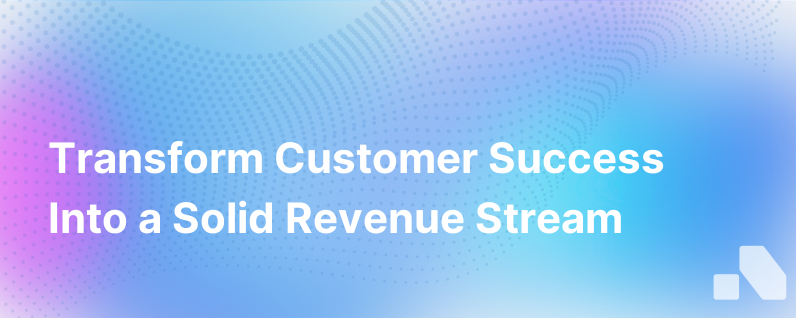
In the ever-evolving B2B landscape, the concept of Customer Success (CS) is often greeted with nods of importance yet side-stepped when aligning roles purely with revenue generation. But, with a closer examination, it’s clear that proactive Customer Success strategies are not merely supportive— they're revenue amplifiers. Let's walk through the journey of transforming Customer Success from a cost center into a treasured revenue driver.
The Evolution of Customer Success
Initially, Customer Success emerged as an antidote to the churn endemic in subscription-based models, particularly within SaaS domains. Over time, organizations realized that Customer Success isn't just about preventing losses; it's an engine that can drive expansion and growth. The transition from defense to offense in the function of CS has become increasingly pivotal in scaling any business.
The Key: Understanding the Value Proposition
Customer Success revolves around ensuring clients reap the promised benefits of your product or service. But the true art of CS lies in understanding that value is not static—it ebbs and flows with customer needs and market dynamics. A dynamic Customer Success strategy allows companies to grow accounts by upselling and cross-selling at junctures when clients are likely to see the most benefit from expanded features or services.
Creating a Proactive Customer Success Model
A passive Customer Success approach reacts to issues as they arise; it’s a model of containment. But when CS professionals transition into proactive consultants who can anticipate needs and advise on best practices, they not only secure customer loyalty but also open up the floor for further business opportunities.
Implementing an Augmented Framework
To reposition CS at the heart of revenue generation, it begins with a comprehensive framework that leverages data analytics, customer feedback, and a robust understanding of each customer's unique journey. Here's how you can cultivate this:
-
In-depth Onboarding: This foundation-setting phase ensures clients start off on the right foot, understanding the full potential of your offering and how it aligns with their goals.
-
Continuous Engagement: Regular check-ins, QBRs (Quarterly Business Reviews), and health scoring keep the conversation ongoing and help in identifying opportunities for offering new solutions.
-
Customer Education: Through webinars, articles, and thought leadership, educate customers about industry trends, aiding in the natural progression towards solutions that address emerging issues.
-
Predictive Analytics: Leverage data to understand and predict customer behavior and needs. This anticipatory approach can help offer additional features before the customer even recognizes their necessity.
Integrating Customer Success with Sales and Marketing
The synergy between Customer Success, Sales, and Marketing departments cannot be overstated. This triad, when harmonized, creates a powerful feedback loop. Customer Success insights can direct Sales and Marketing strategies by identifying which products/services are most likely to meet the extended needs of existing clients.
Cross-functional Collaboration and Upskilling
Cross-pollinating skills among teams is key. Empowering CS team members with negotiation and sales skills allows them to effectively seize revenue opportunities, while Sales and Marketing can benefit from advanced product knowledge and a deeper understanding of the client's post-sale journey.
Measuring Customer Success Impact
Transitioning Customer Success into a revenue stream demands accountability for revenue metrics. Consider the following assessments:
-
NPS (Net Promoter Score): This gauges loyalty and correlates with potential for growth.
-
CLV (Customer Lifetime Value): An upward trend in CLV might result from successful upsells and renewals by the CS team.
-
Expansion Revenue: Track revenue stemming directly from upsells and cross-sells driven by CS initiatives.
-
Renewal Rates: High renewal rates can be attributed to effective CS practices which also lead to new sales through word-of-mouth and referrals.
Success Stories and Advocacy
A customer who has seen success with your product or service becomes a credible advocate. CS can cultivate these success stories and leverage them as tools for marketing endeavors. Think case studies, testimonials, and referrals; not only do these serve as potent marketing material, they also play a significant role in closing new business.
Customer Success Technology Stack
Investing in the right technology can magnify your CS team's efforts. Tools like CS platforms, CRM software, and communication tools ensure your team is equipped to analyze customer data, communicate efficiently, and execute strategic initiatives. Platforms such as Aomni help synthesize information and customer insights, enabling Customer Success teams to work smarter and deliver personalized, data-driven solutions.
Conclusion
Customer Success is transitioning from a supporting role to a featured act in the revenue generation saga. By ensuring that the CS team has a strategic, proactive approach—an augmented framework for engagement, alignment with cross-functional teams—their contribution to a company's profitability can be substantial.
The journey to make Customer Success a core revenue driver is iterative and demands a cultural shift. It involves recognizing the complex, multifaceted roles CS plays in retaining, satisfying, and expanding customer relationships—delivering more than just support, by identifying and acting on growth opportunities.
For startups and mature enterprises alike, doubling down on Customer Success as a dynamic facet of the revenue engine will mean rewriting the script on how we view customer engagement. The intersection of satisfaction and profitability is where the modern Customer Success team operates, turning happy customers into sources of recurring and expanding revenue.